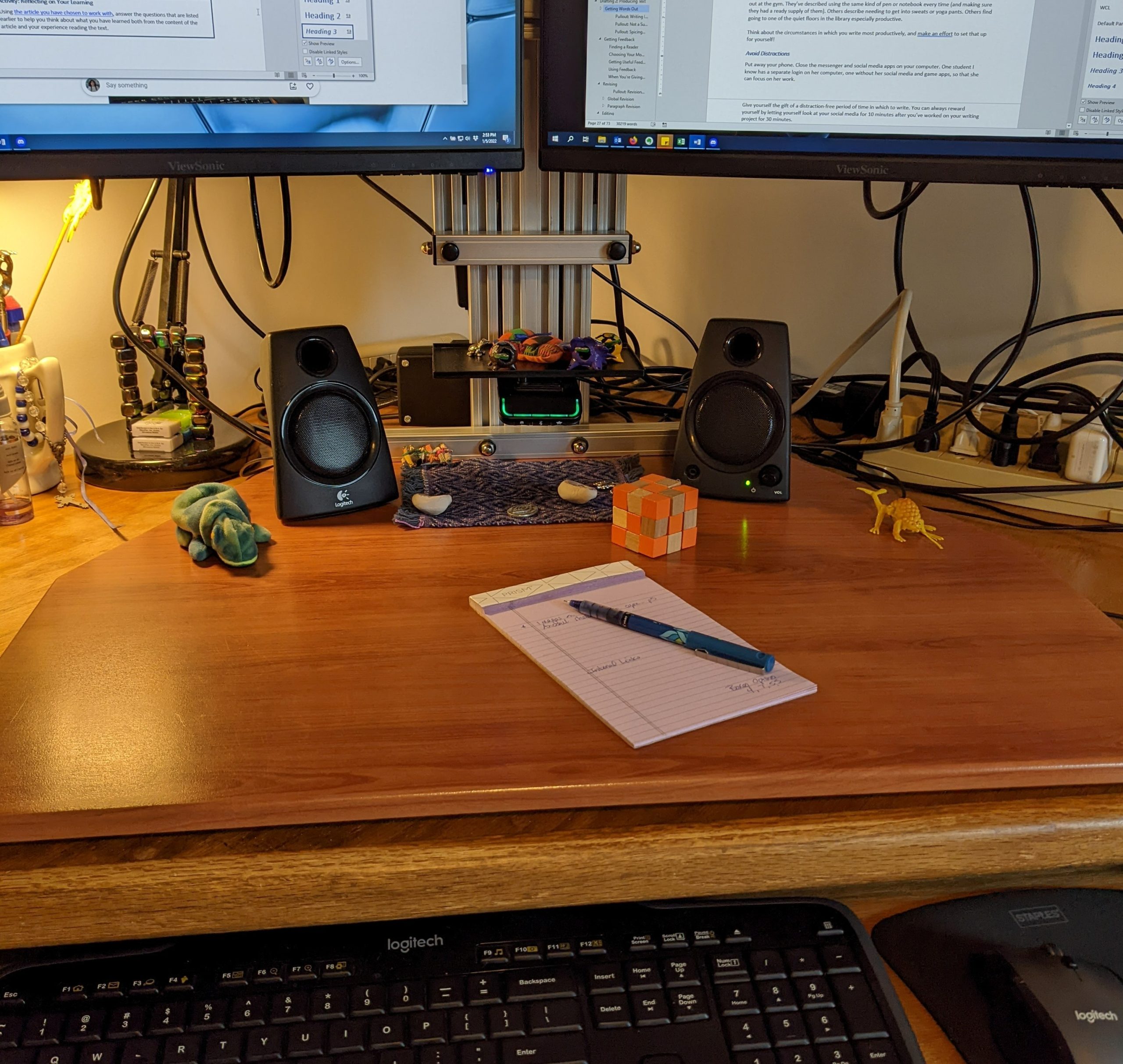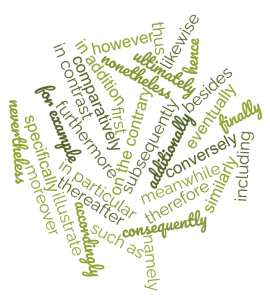Drafting 2: Producing Text
The previous section focused on the structural part of your drafting work. This section focuses on producing text, turning your ideas into actual paragraphs that serve as the basis for your project.
Keep in mind, though that there is no “right” order to the process here. You may be one of those writers who likes to produce a bunch of freewriting on your way to your draft. In that case, you probably already have lots of paragraphs to work with before you start organizing those ideas. I can’t emphasize enough that while there is a trajectory from assignment to final submission, what happens between those points can vary widely. The only “right” process is the one that helps you write successfully.
Getting Words Out
As I was writing this chapter, I found myself getting bogged down in some of the earlier sections. While I had a lot of ideas and material to pull together (as you can probably tell!), I was struggling to write the prewriting sections. The section on reading, which I had drafted first, had gone so smoothly as I worked from beginning to end. This section, not so much.
So, I changed my process. I put together a working outline of this entire section, and then I started jumping around, moving from section to section as the ideas struck me. Sometimes, whole paragraphs emerged. Sometimes it was only a note or two to remind myself of what I wanted to talk about in that section.
If the words won’t come easily, there are many strategies you can use simply to generate text.
Put Yourself in the Mood

Try developing a writing ritual. For example, before I write, I clear the desk in front of me except for a handful of fidget toys, and I get something to drink, usually coffee or tea, but sometimes just water. I play one quick game of Sudoku (not more than 10 minutes). If I’m listening to music—which I really only do when my family is being distracting—I have a specific playlist of alternative classical music without any words and which I associate with getting intellectual work done. These rituals help put me in the frame of mind to write.
I’ve had students tell me that they find writing most successful after they have taken a walk or worked out at the gym. They’ve described using the same kind of pen or notebook every time (and making sure they had a ready supply of them). Others describe needing to get into sweats or yoga pants. Others find going to one of the quiet floors in the library especially productive.
Think about the circumstances in which you write most productively, and try to set that up for yourself!
Avoid Distractions
Put away your phone. Close the messenger and social media apps on your computer. One student I know has a separate login on her computer, one without her social media and game apps, so that she can focus on her work. I shut down my email.
Give yourself the gift of a distraction-free period of time in which to write. You can always reward yourself by letting yourself look at your social media accounts for 10 minutes after you’ve worked on your writing project for 30 minutes.
Talk to Someone
 A conversation with a classmate about your project can be helpful. I’m not talking about a gripe session (though those can help a bit, too) but rather a conversation about the ideas for your paper.
A conversation with a classmate about your project can be helpful. I’m not talking about a gripe session (though those can help a bit, too) but rather a conversation about the ideas for your paper.
You can also try meeting with your professor to talk through your ideas. If that’s too intimidating, visit the writing tutors on your campus. Students seem to think that they need to have a complete essay or at least full-blown paragraphs before meeting with a tutor, but writing tutors can help you think through the ideas for your papers even before any of them are actually written down.
Sometimes that conversation doesn’t have to be in person. For example, when I’m stuck, one trick I use is to imagine that I’m explaining my ideas to one of my sisters. One’s a business owner and an artist, and the other is an executive assistant. Both are smart, but both usually aren’t familiar with what I’m writing about. However, they are also people who know me well, which means that my words tend to flow easily when I’m explaining it to them.
Write Out of Order
Readers (usually) read from beginning to end, but that does not mean that writers must write in that order. Just because your reader reads the introduction first does not mean that you have to write it first. If that perfect introduction is eluding you, perhaps it’s time to work on a different section of the project. Try writing out a rough structure for your paper if you haven’t already, and then jump to a section where you have some ideas. Even just making notes on different sections can get you going.
Try Freewriting
If you find yourself stuck or unsure how best to say what you mean, try setting a timer for ten minutes and freewrite. Don’t forget the strategies that help you ignore the spelling and grammar checkers.
Pace Yourself
 If you don’t procrastinate, you’ll have the time to write a paragraph or two each time you sit down to work on your paper instead of feeling like you have to draft the whole paper at once. It’s usually much easier to write 150 words in a sitting than to write 1500. Write some, then take a break and do something else.
If you don’t procrastinate, you’ll have the time to write a paragraph or two each time you sit down to work on your paper instead of feeling like you have to draft the whole paper at once. It’s usually much easier to write 150 words in a sitting than to write 1500. Write some, then take a break and do something else.
Building Body Paragraphs
Academic writing, like most texts, is made up of paragraphs. Body paragraphs are the places where your ideas are explained to your reader, so they do the most work in your papers. If you are writing good paragraphs and those good paragraphs all contribute to your main idea, your likelihood of success increases.
Defining a Paragraph
When I ask students to tell me what a paragraph is, they tell me that a paragraph is a group of sentences that explains an idea in a piece of writing. They know that a paragraph needs to focus on a single idea and that it’s where evidence is presented and explained. This is all accurate.
But then we talk about length. They tell me that paragraphs are supposed to be at least five sentences. Or seven sentences. Or eight sentences. Nope. There is no set length for a paragraph.
If you aren’t convinced about the number of sentences in a paragraph, try looking at the first paragraph in a news story. Usually, those are single-sentence paragraphs. Magazine articles might have a few sentences, but they might also have one. Now look at the number of sentences in later paragraphs. Again, the numbers will vary, and you will probably find many paragraphs with fewer than five sentences.
This is true even of academic writing. Look at this textbook and see how many short paragraphs there are. Choose a scholarly article in your field and count the number of sentences in the paragraphs. You will almost certainly find at least one paragraph with fewer than five sentences—and probably several.
How long does a paragraph need to be? Long enough to get the job done.
What’s the job? Each body paragraph needs to contribute something substantial to your main idea, so they function as building blocks. Introductions and conclusions are also building blocks, but they have special jobs. Body paragraphs do the bulk of the work in a paper.
You can think of a paragraph as a simple way to chunk information for your reader, making it easier to understand your thesis as your paper develops.Paragraphing is necessary to help your reader understand how you want information to be grouped. If you don’t write in paragraphs, your reader will almost certainly struggle to understand where ideas separate and how those ideas are connected. As we read, we find it easier to hold onto the ideas if we are able to group them, and paragraphs tell us which ideas the writer thinks should be grouped. We can then string together the core idea of each paragraph to better understand the whole text.
Each body paragraph needs to make a supporting point or help make a supporting point. This means that each one has to have a controlling idea (i.e., a topic sentence), support in the form of evidence or explanation (or both), and transitions that link the idea in this paragraph to the ideas in other paragraphs. Let’s work through each of these in more detail.
Developing Topic Sentences
Topic sentences, in effect, summarize the main idea of a paragraph, and a reader should be able to get the gist of your paragraph just from reading that sentence. Like your thesis statement, they make the central point clear, so you can think about a topic sentence like a mini-thesis for a paragraph.
However, topic sentences often do more than summarize. Topic sentences frequently link the point in that paragraph to the controlling idea for the project—or for a section of that project, if the piece is long and complex enough—usually through presenting a more specific angle or focus on your thesis statement. If you are explaining the causes of a problem, a topic sentence might identify one specific cause that the paragraph would then explain in more detail. If you are proposing a solution, a topic sentence might acknowledge that your proposal has limitations, and the paragraph would explain those limitations. If you are describing your research findings, a topic sentence might provide an overview of how you collected your data, and the paragraph would provide specific process information.
View the examples.
Let’s look at a few topic sentences from this text:
- Academic writing almost always has a thesis statement, but not all writing does. You may or may not find thesis statements in personal essays and magazine stories. You probably won’t find them in works of fiction (from “Writing a Working Thesis”).
- Sometimes, students want to ask questions to lead into the rest of their paper. While that can work, those questions cannot serve as a thesis statement because your reader needs to know what you are claiming. “Why should the United States allow in more refugees?” doesn’t provide your reader with any sense of your claim (do you think that it’s a good idea or not?) and doesn’t provide any reasoning. This leaves your reader with too many questions (from “Not Questions”).
- What’s the job? Each body paragraph needs to contribute something substantial to your main idea, so they function as building blocks. Introductions and conclusions are also building blocks, but they have special jobs. Body paragraphs do the bulk of the work in a paper (from “Definition of a Paragraph”).
Notice that in all of these cases, the bold sentences summarize the key point in the paragraph. If you go back and look at the sections in which these paragraphs appear, you’ll see that they are also contributing to the point of the section, reminding the reader (you!) about the ideas in that section and making connections to the ideas around them.
Thesis statements need to appear in a place where your reader expects them: usually the end of the introduction, but occasionally at the beginning. Topic sentences have no such restrictions. Topic sentences often appear at the beginning of body paragraphs, but not always. Sometimes it makes more sense to present your evidence and explanation first, and only after that, would you present your overview of the point. Sometimes, you want to explain some of your points first, and then present your topic sentence, followed by more evidence or explanation. And sometimes, you’ll want to make your topic sentence clear at the end of the paragraph, even though your reader should be able to guess your point.
View the example.
Let’s look at what happens when we move a topic sentence around. I’ll use a paragraph from earlier in this section on topic sentences:
- However, topic sentences often do more than summarize. Topic sentences frequently link the point in that paragraph to the controlling idea for the project—or for a section of that project, if the piece is long and complex enough—usually through presenting a more specific angle or focus on your thesis statement. If you are explaining the causes of a problem, a topic sentence might identify one specific cause that the paragraph would then explain in more detail. If you are proposing a solution, a topic sentence might acknowledge that your proposal has limitations, and the paragraph would explain those limitations. If you are describing your research findings, a topic sentence might provide an overview of how you collected your data, and the paragraph would provide specific process information.
This paragraph begins with the topic sentence, but that sentence could have appeared in other places in the portfolio. I could have put it in the middle, for example:
- Topic sentences frequently link the point in that paragraph to the controlling idea for the project—or for a section of that project, if the piece is long and complex enough—usually through presenting a more specific angle or focus on your thesis statement. Thus, topic sentences often do more than summarize. If you are explaining the causes of a problem, a topic sentence might identify one specific cause that the paragraph would then explain in more detail. If you are proposing a solution, a topic sentence might acknowledge that your proposal has limitations, and the paragraph would explain those limitations. If you are describing your research findings, a topic sentence might provide an overview of how you collected your data, and the paragraph would provide specific process information.
Or I could have put it at the end:
- Topic sentences frequently link the point in that paragraph to the controlling idea for the project—or for a section of that project, if the piece is long and complex enough—usually through presenting a more specific angle or focus on your thesis statement. If you are explaining the causes of a problem, a topic sentence might identify one specific cause that the paragraph would then explain in more detail. If you are proposing a solution, a topic sentence might acknowledge that your proposal has limitations, and the paragraph would explain those limitations. If you are describing your research findings, a topic sentence might provide an overview of how you collected your data, and the paragraph would provide specific process information. Thus, topic sentences often do more than summarize.
Part of my job as the writer is to determine which placement is most effective at conveying what I want to convey. And sometimes, it is just a matter of your writing style.
The point is not where you place a topic sentence, but rather that you have one—most of the time. Upon rare occasion, you will want to have your reader infer the main point of the paragraph rather than get that point directly from you. A couple of cautions. First, most instructors will prefer explicit topic sentences. Second, when you take this approach, you run the risk that your point will be misunderstood.
Narration is an exception. Narrators rarely lay out their points in obvious ways. How much would it have taken away from Star Wars IV: A New Hope for someone on the Death Star to announce that Darth Vader is the movie’s bad guy? But since you won’t be writing narration for most of your academic projects, this technique is best used sparingly.
Incorporating Evidence
The bulk of your body paragraphs will be made up of two parts: evidence and explanation. When someone says that a paragraph or project is well-developed, they tend to mean that there is enough of both of these to support the author’s point.
Evidence is the material from others; you may have heard this called “support.” Evidence is often in the form of quotations and paraphrases, but it also includes facts and statistics, and even just other people’s ideas.
I prefer the term evidence because “evidence” is neutral until you do something with it. A fingerprint at a crime scene doesn’t mean anything until investigators connect that fingerprint with a particular person. The fingerprint itself is neutral until we make meaning with it.
To be clear, in this section, I am talking about evidence from texts created by other people. While data you have gathered for a lab or research report would also be “evidence,” your professors frequently expect you to use writings and other textual sources to support your claims. In another chapter, I get into the technical aspects of using material from sources, but here, I want to discuss more generally how evidence from other sources functions in a piece of writing.
How much evidence do you need in a successful body paragraph? The answer is layered, so bear with me. The short answer is “enough,” with the understanding that “enough” is mostly determined by your reader. You will have to provide enough evidence to convince your reader that what you are claiming is accurate, reasonable, and well documented. Sometimes, a simple paraphrase from a researcher will suffice. Sometimes, you will need to provide a pile of statistical information or quotations from multiple sources. Think about what your reader already knows. The more familiar the information, the less time you will have to spend presenting evidence.
 Your reader is the first determiner, but you also have to consider your purpose. If you are writing an informative piece where your primary job is to provide information from reputable sources, your reader is going to expect lots of evidence from your sources. If you are writing an argumentative piece where you are primarily presenting your ideas, your reader is going to expect a bit less from other sources and more explanation from you.
Your reader is the first determiner, but you also have to consider your purpose. If you are writing an informative piece where your primary job is to provide information from reputable sources, your reader is going to expect lots of evidence from your sources. If you are writing an argumentative piece where you are primarily presenting your ideas, your reader is going to expect a bit less from other sources and more explanation from you.
The next layer is that evidence may not be distributed evenly over the course of your paper. As an obvious example, you rarely present evidence in your introduction and conclusion. But you may have some paragraphs in which you need to present a case from a source in detail. You may have other paragraphs that are spent entirely in your explaining your own ideas. So, when you are thinking about how much evidence you need, you’ll want to think about that amount in terms of your entire project, not necessarily in each paragraph.
Next layer: Your professor doesn’t want to hear your sources; your professor wants to hear you. We have a saying, “The evidence speaks for itself.” This is not, in fact, true—at least not in academic writing. You cannot assume that your audience will reach the same conclusions you do just because you point out a fact. You have to provide explanation, and probably more of it than you believe you need.
Taking all of these layers together, we can identify some general guidelines:
- In general, you should expect evidence from other sources to occupy 25-50% of your project.
- For informative pieces, your evidence level may be closer to 50%.
- For argumentative pieces, your evidence level may be closer to 25%.
- If you are writing a project in which the evidence is coming from something other than textual sources (such as your own experiment results), you will almost certainly have less than 25% and maybe as little as 0% coming from textual sources, depending on the assignment.
Guidelines are not rules, so you should not treat these as absolutely. Instead, if you see yourself veering too far from these, do a check-in. Do I really need that much evidence? Do I need more?
 This activity can help you visualize the amount of evidence in your draft. Once you have a draft that you think has enough material in it, do the following:
This activity can help you visualize the amount of evidence in your draft. Once you have a draft that you think has enough material in it, do the following:
- Highlight (either with the highlighter feature in your word processor or with a pen) all of the material that is coming from some source other than you.
- Take a bird’s eye view of your paper. Scroll out until you can see the color but you cannot read the text, or lay the paper out on a surface and step back until you get that kind of distance.
- Do a rough percentage estimate of the amount of evidence you have.
Now consider what this means for adjusting the amount of evidence in your writing, given the audience and purpose for your project:
- Is the overall percentage too much, too little, or about right?
- Identify any sections of your project with too much evidence (and thus too little of you).
- Identify sections of your project with too little evidence (and thus too much of you).
You can use this analysis to guide your revision work.
Providing Explanation
 The other half of development is explanation. Evidence presents material from others; explanation presents your own ideas and reasoning. In college-level assignments, your professors are not usually interested in just hearing you piece together the ideas of others. Instead, they want to hear your points about those ideas. Why are they important? Where do you think that the authors of those sources are drawing strong conclusions and where are they missing the boat? How do the ideas from your sources apply to your points, given your experiences and your point-of-view? All this and more are involved in your explanations.
The other half of development is explanation. Evidence presents material from others; explanation presents your own ideas and reasoning. In college-level assignments, your professors are not usually interested in just hearing you piece together the ideas of others. Instead, they want to hear your points about those ideas. Why are they important? Where do you think that the authors of those sources are drawing strong conclusions and where are they missing the boat? How do the ideas from your sources apply to your points, given your experiences and your point-of-view? All this and more are involved in your explanations.
If evidence involves between 25% and 50% of your paper, the other 50-75% must come from you. Even the most informative pieces are not simply regurgitations of someone else’s ideas. You must be articulating the significance of those ideas, making connections among them, arguing in favor of or in opposition to specific points, and otherwise making your voice prominent in what you write, even when you aren’t writing a personal essay.
This seems like a tall order. If the sources are making a good case, what do you have to add? Students seem to struggle most with this in heavily informative assignments. In high school, for example, you may have been asked to construct a report on a given topic that synthesizes multiple sources and your voice might not have been important in that report.
But in college, your professor wants to understand how you see the evidence. What makes sense to you, and how does it make sense? If it doesn’t, where are the gaps or contradictions? This all gets at critical thinking, a topic much larger than this text can cover, but suffice it to say that your professor is less interested in whether you can correctly list all of the facts and more interested in whether you can effectively explain what those facts could mean. This means you cannot rely on evidence to carry you through. Instead, you need to explain your ideas.
View the examples.
There are many ways to explain—and not all of them involve evidence. Here are some ideas:
Examples of Evidence-Focused Explanations
- Explain the connection between a piece of evidence you are presenting and the point you are making in that paragraph or in the project as a whole.
- Explain how the evidence presented is accurate or how it isn’t accurate.
- Provide additional detail to explain how the idea in the evidence works.
- Make connections between pieces of evidence.
- Explain the significance of the evidence you have presented.
- Explain the context of or background behind a piece of evidence.
Examples of Other Kinds of Explanations
- Present your own position and the reasoning for that position.
- Analyze the ideas and/or language of others.
- Walk your reader through the logic of your claim.
- Tie together different parts of your project so that the connections among the ideas are explicit.
- Provide details, examples, or other specific information based on your experience.
- Provide your response to others’ ideas.
There are plenty of other ways of explaining your point to your reader. Think about what you want your reader to understand and use that to guide your choices.
Sometimes, students have difficulty figuring out what to say, particularly when writing with sources. When you are writing with textual sources, it can be easy to let your sources do the talking for you. This approach won’t work in college—and may even cause you to plagiarize inadvertently. If you’ve already done a bunch of reading and thinking about your topic, you have the ideas to work with, but if you leave your sources open in front of you, you are more likely to simply repeat what they say.
This exercise will help you generate draft explanations in your own words without relying directly on your sources.
After you have become familiar with the ideas in your sources, choose a body paragraph that you haven’t yet written that will need information from one or more of those sources.
- Close your sources, and think about the purpose of the paragraph that you are working on and what your reader already knows.
- Draft your explanation without opening your sources. Your goal is to explain as much as you can in your own words.
- If you come to a place where you need specific information from a source, do not open that source (yet). Instead, make a note (e.g., “Need quote from Smith about the number of pigeons in NYC”) and keep writing your explanation.
- Once you have finished drafting your explanation, open your sources and fill in the information.
One more note on the development of your body paragraphs. In much of your academic writing prior to college, you could probably explain your ideas in a single paragraph. In college-level writing, however, sometimes you will need two, three, or even more paragraphs to thoroughly explain a single idea. If you try to cram too much material into a single paragraph, you are very likely to end up with insufficient explanation and a paragraph that is way too long.
While there is no “correct” number of sentences in a paragraph, your paragraphs can be too short or too long.
In general, you will find that body paragraphs in academic papers will be at least half a page in length when you format your papers for your instructor (usually double-spaced, 11-12-point font, 1” margins). This is because it usually takes at least half a page to present a topic sentence plus enough evidence and explanation to make your point. If you have one or more paragraphs of less than half a page, look to see if they make sense joined with any of the paragraphs around them. You might find that you really need the short paragraph, but make sure you check.
Similarly, if paragraphs take up a complete page or more, you are asking your reader to hold on to a lot of detail without providing them with a way to chunk the information and thus without a way to fully understand your point. Overly long paragraphs can undermine your message. If you find yourself with a paragraph that runs more than a full page, look for a place where you can split the paragraph into two or three sections. You can use transitions of similarity to help your reader understand that you are talking about the same topic over multiple paragraphs. See the next section for more on transitions.
Including Transitions
 Transitions make connections among the ideas in our writing. These are the words and phrases that help our writing “flow,” a word I commonly hear students use. Transitions do much more, though, than make our writing sound smooth. They provide our readers with logical connections, information about how the ideas in your writing are connected to one another. As such, they are part of your explanations in a text.
Transitions make connections among the ideas in our writing. These are the words and phrases that help our writing “flow,” a word I commonly hear students use. Transitions do much more, though, than make our writing sound smooth. They provide our readers with logical connections, information about how the ideas in your writing are connected to one another. As such, they are part of your explanations in a text.
Most students are familiar with “transition words,” such as “first” and “however.” Transition words have a logic to them. For example, words like “also” and “similarly” indicate similarity, while words like “however” and “but” indicate difference or contrast. You can find many good lists of these words and their logic on the internet. One that I recommend is available from the University of North Carolina at Chapel Hill’s Writing Center (“Transitions”).
Sometimes, though, transitions are longer than single words. In long essays, for example, there may be entire transition paragraphs, paragraphs that sum up what has been explained before and that make a connection to the upcoming ideas. Transitions of this length become more common in long academic essays—at least 3000 words and usually more like 6000—so you are unlikely to need to create them until you are doing advanced coursework in your major, and perhaps not even then.
Transition sentences, however, are common in essays of all lengths. These sentences are almost always the first sentence in a paragraph, and they include two logical moves: a “gesture backward” and a “gesture forward.” Your reader needs you to use transition sentences to help them understand how the old information (what you’ve already discussed) connects with the new information (what you are about to discuss).
The “gesture backward” part of a transition sentence references something that has already been discussed, usually an idea that was just discussed in the previous paragraph, though not always. It provides a kind of summary or highlight of a key point that the writer wants the reader to keep in mind as they move into the next point.
The “gesture forward” part of a transition sentence introduces the next point. Sometimes, this introduction also serves as a topic sentence, but not always.
Unlike topic sentences, which can appear anywhere in a paragraph, transition sentences usually need to be the first sentence of a paragraph (or very occasionally, the last sentence in the previous paragraph) because that is the moment when you are shifting focus.
Let’s look at a sentence from earlier in this section: “Sometimes, though, transitions are longer than single words.”
- In this sentence, “though” is a transition word that indicates contrast. This tells your reader that you are going to talk about something different from what you have just discussed.
- What will the contrast involve? The reference to “single words” is the gesture backward because this sentence appears right after a discussion of “transition words” that are mostly single words.
- The use of “Sometimes” and “longer than” serve as the gesture forward (and the other side of the contrast), indicating that this upcoming paragraph will discuss times when transitions are longer than single words.
All of these parts work together to help you (the reader) understand the logic that I am using as I explain how transition sentences work.
Transition sentences connect ideas across paragraphs. Readers are better able to understand what connection the writer wants them to make because of both gestures. Notice that the gestures do not need to be of equal weight. It is quite common for the gesture backward—the one that sums up what the reader has already read—to be much shorter than the gesture forward. But there is no hard rule on this.
Transition sentences almost always occur at the beginning of paragraphs because a complete transition sentence must include the gesture forward, which means that it is introducing a new topic. If a new topic appears in a paragraph, it requires explanation in that paragraph or some indication that the topic will be handled later. This happens, for example, when a paragraph introduces two or three subtopics, but details only the first of these in the current paragraph.
Choose a body paragraph in a draft of a paper that you have been working on, and examine the first sentence. Does that sentence function as a transition sentence from the previous paragraph to the current one? If not, try drafting a sentence that does this work.
Once you have a transition sentence, look for the following parts:
- Is there a gesture backward (some reference to what you have discussed earlier, preferably in the previous paragraph)? If not, could you add one?
- Is there a gesture forward (some reference to what you discuss in the current paragraph)? If not, could you add one?
- What is the logical relationship between this paragraph and the paragraph before? Are there any transition words or phrases that could help make the relationship clearer for your reader?
You can check these opening sentences throughout your work, but this is most effective once you have a solid draft of your project.
Writing Introductions
 The job of any introduction is to move your audience from their world into the world of your creation, whether that is a piece of music, an argument, a novel, or a report.
The job of any introduction is to move your audience from their world into the world of your creation, whether that is a piece of music, an argument, a novel, or a report.
Academic introductions specifically need to do the following three things:
- Introduce your topic
- Explain your position in your thesis statement
- Get your reader interested in what you have to say
Introducing your topic tends to be easy and can happen as you do the other two. Just make sure that by the end of your introduction, your reader knows the subject matter of your project. Academic writing is not mystery writing.
The thesis statement is particularly important, and in an academic paper, it must appear in your introduction. Placement in that introduction matters, too. It’s almost always clearest to put your thesis statement last. If your thesis is buried in the middle of your first paragraph, you run the risk of confusing your reader. If you place your thesis statement last, you are priming your reader to start understanding the reasons behind that statement. If you put it earlier, your reader might not be sure exactly what you are starting to explain at the beginning of the body of your paper.
Getting your reader interested is sometimes called a “hook,” but before you try thinking about how to get your cousin the basketball player to be interested in your paper on the effects of climate change on aquifers in China, remember what I’ve said about audience. You aren’t writing for a “general audience”; in academic contexts, you are usually writing for a reader who is already at least generally interested in the topic. This means that you won’t have to create some kind of catchy way to get them to read your ideas. You will still want to make that topic interesting and relevant, but your opening doesn’t need to try to appeal to everyone. Instead, think actively about who your reader is and what they already know. How can you get that already-somewhat-interested reader to enter the world of your paper?
There are a number of techniques you can use to open a paper, and the one(s) that you choose will depend on your audience and purpose:
- Use a quotation, statistic, anecdote, or example, particularly one that might surprise your reader. If they are surprised by what you say, they are more likely to keep reading. Be careful, though, not to use extremes here. If you do, you are encouraging your reader to doubt your position right from the beginning.
- Present an overview of the topic. This could be a (brief) explanation of the background or history of your topic or a description of the sides that people take if you are writing about a controversy.
- Explain a key term or concept central to your paper. Doing this kind of explanatory work at the beginning can help your reader understand the more detailed position you are going to take up in your paper. Be careful, though, about opening with a definition from a standard dictionary. Unless you are going to do something with the way that the common understanding is too limited or otherwise misses the mark, these definitions are usually too generic to be useful for academic writing.
- Ask a question. Questions can be effective as an invitation to get your reader to start thinking of how they would answer the question. Make sure, though, that if you ask a question in your introduction, you answer it in your paper. And remember that your thesis statement cannot be a question.
There are many ways to write an introduction, but here’s one example. It introduces the topic and has a strong thesis statement, and it makes the reader curious about the specific barriers:
The transition to renewable sources of energy is mainly hampered by major political barriers which reduce access to funding, although there are also physical and environmental constraints. In the United States specifically, the financial roadblocks, political manipulation, misinformation, technological barriers, as well as the lack of efficiency of renewable energy sources play a critical role in hindering the goals of transitioning away from fossil fuel sources. In fact, acquisition of capital investments within the American financial system can be politically manipulated despite the U.S. being an open capitalist market. The interplay between inadequate funding, political manipulation, and misinformation presents unique challenges that hinder our transition from fossil fuels to renewable energy.
Writing Introductions Last
Writing Conclusions
 Conclusions are designed to move your reader back out of the world of your paper and into their own world. Ideally, you want your reader changed in some way—at the very least, more knowledgeable about the topic than when they began.
Conclusions are designed to move your reader back out of the world of your paper and into their own world. Ideally, you want your reader changed in some way—at the very least, more knowledgeable about the topic than when they began.
Academic conclusions specifically have two key jobs:
- Remind your reader of your key point
- Move your reader toward some kind of action or change
In the past, you may have been told to use your conclusion to sum up your paper: say what you said. At the college level, this is not the primary work of a conclusion, and sometimes, you don’t need to do any summarizing at all. Think of it this way: if your reader is intelligent—and we’re usually assuming they are—do they really need a summary of the two or three pages they just read?
Instead, it is much more important to get your reader to take your ideas back out into their world, so that part should take up the bulk of your conclusion.
Generally, you will want to remind your reader of your main point. This often takes the form of a restated thesis, but you want to make sure that you are not using the same wording as your thesis in your introduction. Sentences that simply repeat what you’ve said earlier can bother the reader and make you seem lazy, like you haven’t done enough thinking about your topic to have more than one way to explain your point.
Depending on how long your project is, you might be able to skip that restatement. For very short projects (500-1000 words), a summary, even a brief one, usually isn’t necessary. For papers between 1000 and 2000 words, a sentence or two at most is enough to remind your reader of your key points.
Sometimes, you can remind your reader of your point at the same time as you make a case for why your ideas matter.
Academic conclusions need a “so what?” answer. You should give your reader a clear understanding of why the topic matters and, where appropriate, what needs to be done. Here are some ways to do that:
- Explain the subject’s significance. Explain why this topic and your position on it matter in the larger world. This approach can work well if you have a topic that your reader might underestimate or minimize.
- Offer a solution or recommendation. If you have spent most of your paper analyzing a problem, it is perfectly fine—and even recommended—to offer some sense of a solution in your conclusion.
- Speculate. Speculation can work well if you have been analyzing a problem that has no obvious solution or one that people would be resistant to accept. Speculation can also work well if your paper has been proposing a solution. In those cases, the conclusion can emphasize why your proposal is needed.
- Make a call for more research. This approach tends to work well when you are exploring a new area of research or a recent phenomenon. Note that you can really only make this kind of call in a project for which you have done extensive research into what is already published. If you don’t know the research that is available on the subject, you can sound foolish for asking for more research that has already been done.
A word of caution on all of these. Writers often have the desire to make their topic sound like it is of supreme importance or a matter of life or death. Don’t overstate the significance. A college-level academic audience doesn’t need extremes to understand the importance of an analysis or the value of a proposal.
Just as there are many ways to begin your paper, there are many ways to end it, too. Here is an example of a good working conclusion in three sentences. The first sentence summarizes the paper. The second sentence pushes the reader to act on the issue presented in the paper—or at least keep the issue in mind. The final sentence gives the reader an idea of how the issue can be fixed:
Renewable energy can be achieved in the U.S.; however, there are critical barriers to this infrastructure. We need to act as soon as possible if we want our planet to survive for the next generation. Most of the responsibility falls onto politicians because they hold the power to change policies and limit misinformation, which would then make it easier for the public and investors to support renewable energy.
Spicing Up Your Conclusion
Some of the techniques that work in introductions can also work in conclusions.
You can, for example, ask a question (and either answer it in your conclusion or make it clear that the audience should answer it for themselves). Be warned, though, that questions like “What would you do?” or “What are you going to do?” are cliched and likely to irritate your reader.
One technique that can be quite effective is to use your conclusion to echo, extend, or answer something that you set up in your introduction. For example, you might open with an anecdote about a person and then close with an explanation of what happened to that person as a result of issues you discuss in your paper. Or you could reiterate a statistic with some discussion about how we can better understand that statistic based on your analysis in the project.
However, these approaches are spice—added flavoring that can make your conclusion more engaging and more memorable. They cannot replace the core work of a college-level academic conclusion.
Key Points: Producing Text
- Especially early in your process, it is more important to get words flowing than to worry about producing perfect paragraphs. Help yourself do this by writing in a comfortable setting, limiting distractions, writing out of order, talking with people about your project, freewriting, and pacing yourself.
- Strong academic body paragraphs usually include a topic sentence (which can also be a transition sentence) and enough evidence and explanation to convince your reader of your point.
- Evidence presents ideas from your sources.
- Explanation presents your ideas.
- Your reader needs transitions to understand how you are making connections among the ideas in your writing.
- Introductions must include your thesis statement and an introduction to your topic. They also generate interest in what you have to say.
- College-level conclusions may include a restatement of your thesis, but they do not summarize your paper. Instead, they suggest changes in your reader’s thinking or actions based on the ideas in the paper.
Media Attributions
Conversation Over Text, Photo by John Schnobrich on Unsplash
“To Do List Scene” by VideoPlasty.com is licensed under CC BY-SA 4.0
Scales, Photo by Elena Mozhvilo on Unsplash
Explaining, Photo by No Revisions on Unsplash
Introduction, Photo by Bundo Kim on Unsplash. The photo was cropped before adding it to this chapter.
“The Thinker by Auguste Rodin, Grande Palais, Paris, 13 July 2017” by Joe De Sousa on Flickr is in the Public Domain, PDM 1.0
Text Attributions
The “Developing Topic Sentences” section of this chapter contains material taken from the chapter “Do Quick Research” from The Word on College Reading and Writing by Carol Burnell, Jaime Wood, Monique Babin, Susan Pesznecker, and Nicole Rosevear and is used under a CC BY-NC 4.0 license.
The example introduction and conclusion, with some revision by me, are provided by Geoffrey Pierre, a student in my class during Spring 2022.
Sources that have been evaluated by experts in the field, also sometimes called "scholarly sources"; these sources are considered the most reputable in academic settings.
A sentence that summarizes the main point of a paragraph.
A word or group of words that guide the reader logically from one idea to the next in a text.
A kind of thinking characterized by logical, objective analysis and evaluation based on evidence.
The controlling idea for an academic text, though some other kinds of texts may have such a statement, too. See also "working thesis statement."

